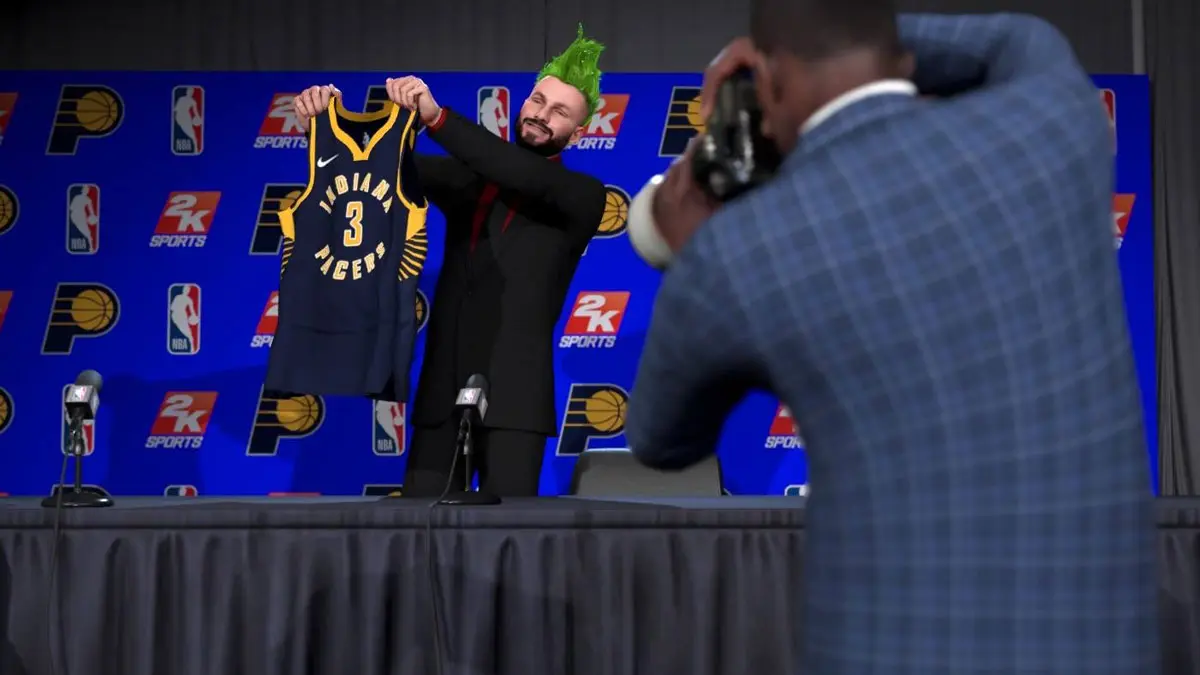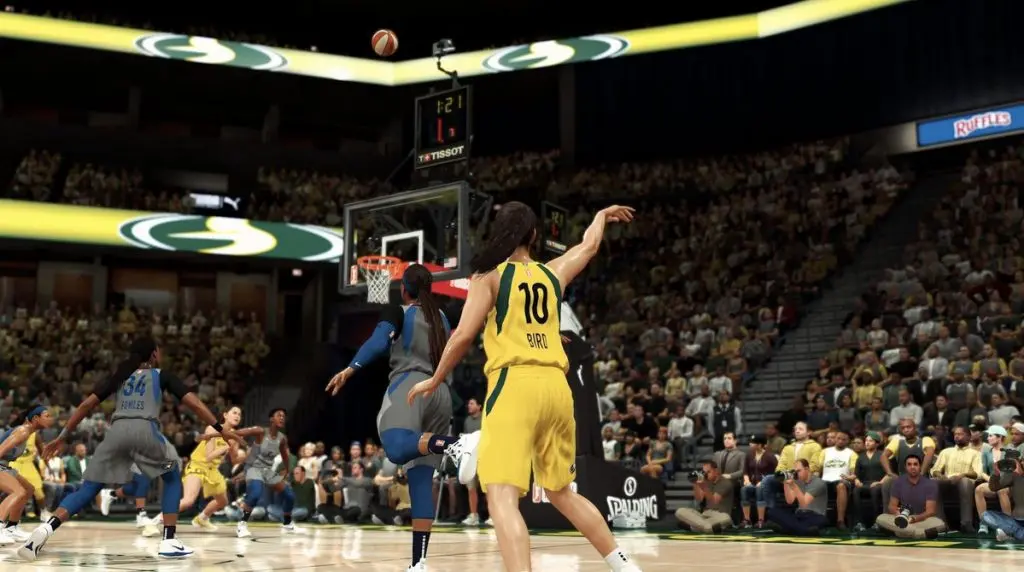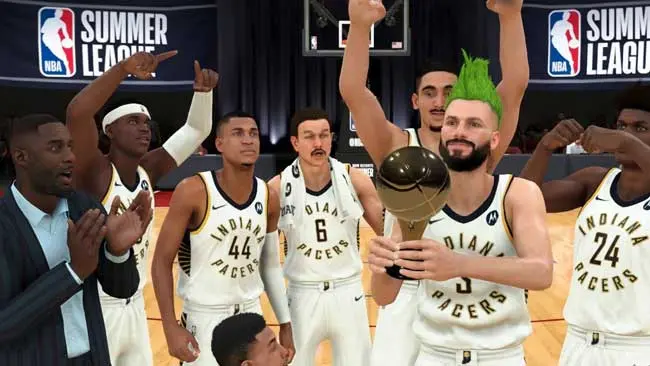
Widely considered the best IP in sports sim video games, Visual Concepts’ NBA 2K series has consistently gone above and beyond expectations with its tight sim gameplay, lifelike production values, and a vast collection of features and game modes.
Suffice to say, NBA 2K20 stands out as the most content-heavy and all-inclusive installment of the franchise to date. As a matter of fact, 2K20 just might be one of the biggest and best sports games I’ve had the chance to play in years. Attention to detail and authenticity have always been pillars of the NBA 2K brand, and this season does not disappoint in either regard.
For this critique of NBA 2K20, I will begin with a section to summarize and comment on the primary game modes and the newest core features. In the second part, I’ll discuss the major gameplay tweaks and mechanical differences introduced this season. Finally, the third portion will tie up the loose ends and the conclusion.
GAME MODES & NEW FEATURES
NBA 2K20 comes packed with all of the usual modes that fans like myself have come to expect. The core features are largely the same: MyCareer, MyTeam, MyLeague, MyGM, etc. There are a few new wrinkles in each mode, which helps to keep things fresh for yet another season.
Now, let’s break down each of them individually.
MyLeague is the general “franchise” mode of the 2K series. It allows you to take full control over as many NBA teams as you’d like, for the current season and many decades to follow. You can begin with the current NBA rosters, or you can organize a fantasy draft if you prefer to mix up the power in the league instead. In addition to playing as many of the scheduled games as desired for all of your selected teams, MyLeague mode lets you manage out-of-game tasks such as the coaching settings, roster changes, contract extensions, player trades, free agency, and so on. This mode does allow for a few new options, but it is basically the “Old Faithful” of NBA 2K, and it won’t let you down.
MyGM is quite similar to MyLeague. The key difference in this mode is that it primarily focuses on the administrative, front office, and ownership aspects of your team, rather than all the action on the court. This mode is clearly aimed at players who are into the long-term logistics, executive tasks, and responsibilities of running a franchise. It’s not really for players who just want to jump into a quick game. MyGM never appealed to me as much as MyLeague, but it’s nice to see that it keeps coming back more or less unscathed for those that are really into the executive and ownership realms of pro sports.
MyTeam returns yet again with its wacky process of team-building via pulling random players from packs of digital cards. As is tradition, the various player cards you can acquire range in their effectiveness and “value.” Each card is marked by a rating such as Diamond, Ruby, Emerald, etc. Additional card packs are obtained over time using your in-game credits (the same special credits that you spend in every other mode).
This has been the routine for years. When you inevitably run out of credits, you can buy more via microtransactions using real money. Although it may not be absolutely mandatory to spend your cash to buy more credits, it’s not only highly suggested – it’s blatantly advertised, and damn near necessary just to have a few great cards. If you have any hope in being competitive in MyTeam online, you may need to spend a couple of extra bones.
If this sounds like your cup of tea, great news; you’ll probably enjoy it as much as previous entries. Personally, I don’t like it at all. I absolutely loathe microtransactions in general, but especially when there is such a large degree of random luck thrown into the equation. I’m not at all surprised that this feature has garnered a lot of controversy. Many consider this whole purchasing model to be a form of gambling, and it has even been banned in a handful of countries. I’m quite curious to see how 2K Sports responds to this – especially the notions that 2K20 deserves an Adults-Only rating from the ESRB for all the “virtual gambling.”
MyCareer is the primary focus, the bread and butter of 2K20, as far as I’m concerned. This story-driven component revolves around the career of a player that you create, beginning in college and running all the way to retirement.
The plot of MyCareer is actually pretty damn compelling this year. It stars Idris Elba as your team head coach along with plenty of current and past NBA stars. The dialogue is pretty solid, and the voice acting doesn’t make you cringe (ahem, 2K16). The production values, in general, are flashy.
The story proves to be quite a roller coaster, for reasons I won’t spoil for you. Basically, your player chooses to stick around late in his college basketball years rather than trying to quickly go pro. The journey sees you facing plenty of skepticism from your friends, coaches, agents, even TV analysts. All of the major exposition is packed into movie clips that play out between practices and games. There are even some live-action broadcast clips and commentary just for the added realism. It’s all pretty slick.
Eventually, you graduate and earn the chance to compete in the NBA Draft Combine, and then it’s your shot at entering the NBA Draft. Once you get drafted, you’re sent off to play in the NBA Summer League. Your performance during the summer games greatly dictates your spot on the team roster as the regular season inches closer.

When your rookie season finally begins, it’s up to you to write the chapters of an up-and-coming NBA superstar. If you’re drafted to a team that needs help at your position, you just might be a starter right out of the gates. You could also be stuck on the bench, waiting for the right chance to shine or for an injury to open up that starting position.
As you gain more precious minutes per game, you earn the respect of the coaches and the chemistry of your teammates, all of which makes everything start to come together as a unit. You’ll build up your stats and skills with each day’s team practice routine, as well as for each individual game performance. Based on how you initially build your player, some skills may or may not develop.
2K20 seems to have killed the ability to create cheesed-out players like the previous games. For example, my shooting guard had excellent shooting skills and a few extra inches on the average two guard. This makes rebounds easier to come by, but it comes at the expense of some lateral movement speed and vertical jumping ability. This time, you really have to think about what skills and ability badges that you’d like to focus on; it’s nearly impossible to end up with a player with 99s in every stat category.
Once you start picking up a fan base of your own, you can choose and manage your own endorsement deals with a variety of different brands: Jordan, Nike, Adidas, Puma, etc. Some of the endorsement perks include new shoe contracts, doing motion capture for 2K Sports, designing a custom Gatorade bottle, and even landing potential movie deals through your agent. These endorsements help you accrue more fans and sell yourself, as well as your own interactions during any pre- or post-game interviews throughout the season.
In MyCareer mode, you really get the sense that you’re crafting the image and tone of your own budding NBA legacy. It is easily my favorite part of 2K20, and I am thrilled to see that all the major changes to this mode added so much more depth and player involvement beyond anything in the previous entries in the series.
MORE MODES & FEATURES
In addition to the aforementioned game modes, 2K20 offers some of the basics. Play Now mode is the place for quick pick-up matches. Blacktop is back with the arcade-style, 3-on-3 streetball games. The extensive 2KU training mode offers tutorials for those who need to brush up on the new advanced controls, offensive plays, defensive schemes, and so on. (You can find out more about the new game mechanics and controls in the next section of this review.)
Now that I’ve covered the primary game modes, I’d like to discuss my personal favorite brand-new feature in 2K20. I am talking about the full WNBA league that was added to the game, complete with the current rosters for each squad. Yep, professional women’s basketball finally got some love from video games, and it’s all done quite well.
All of the WNBA games I played before writing this review were a blast, and they captured the important differences in women’s hoops versus men’s. They definitely don’t play the same as standard NBA games. To put it simply, the games turn into relentless, up-tempo, three-point shooting galleries, with both teams trading blows from long-range almost every possession. There really isn’t as much of a focus on post moves or interior play, and the general pace of the games are quicker than men’s games. This might be because the female players feel a bit more agile and speedy to control, or maybe just because my friend and I were dead-set on lobbing bombs at each other from downtown until someone missed.

Ultimately, the addition of the WNBA teams almost makes it feel like there is a separate game bundled into 2K20. I look forward to seeing how the WNBA features could expand if the league is still included in future versions of NBA 2K. I applaud the NBA 2K dev team for the nod to inclusivity this season, and I hope that it can help bring more fans and interest to the league.
Now that we have wrapped up most of the key features and modes, I’d like to tell you about the major changes to the gameplay and some of the series’ basic mechanics.
GAMEPLAY & NEW MECHANICS
To be brutally honest, my time with 2K20 started out quite poorly, as it did for many people. Indeed, it took me quite some time to understand exactly why I was struggling more with this version than I ever had playing its predecessors; it went beyond just the post-launch bugs. The simple fact is that 2K20 has upended some of the most basic functions and controls, and this may come as a very unwelcome surprise to impatient players.
First of all, the controls are tighter and simpler than before. The right stick is used along with the triggers and other buttons to pull off a wide variety of nifty dribbling, shooting, and passing moves. The difference between doing a flashy crossover and a step-back jumper might be nothing more than the hand you’re dribbling the ball with or the direction toward the basket you’re facing.
I know I just said that it’s simpler than before, but the learning curve will convince you otherwise. It takes a bit of practice to feel completely acquainted. If you wildly flick the stick around thinking you’ll spin and hop step gracefully, you’ll probably end up fumbling the ball away or tossing it cross-court and out of bounds. Likewise, even the basic movement controls demand some discipline and finesse. The use of the sprint button in 2K20 has changed dramatically, and you’re informed not to abuse it. If you choose to hold it down constantly as you run up and down the court, your player will wear out very quickly. In fact, sometimes they won’t even make it back in time to set up and defend their man.
If you are wondering, this isn’t because the overall stamina ratings in 2K20 have tanked; it’s just how the new movement and momentum system works. You’re actually instructed early in the tutorials to use the sprint button sparingly, and you’d be wise to listen. I didn’t, so literally dozens of games went by where I was baffled at my player’s inability to keep up. Without even holding the sprint button, most players can jog along at a suitable pace and keep up without overexerting themselves.
When it comes time to slam down the sprint button, movement is much quicker and more aggressive but also more erratic and deliberate. This leaves you with less room for error. Basically, if you miss a full-speed attempt to run into the post and jump to swat at the ball, you might very likely end up stumbling into the damn goalpost or the first row of the crowd like a clown.
You can’t just lazily post up on opponents anymore, nor can you be effective on defense if you stand on their toes and swipe at the ball with the sprint button held down. The ball defender controls and post-up moves are much more sensitive too. As an example, rather than using the jump/block button to contest a mid-range shot attempt, you’re supposed to gently hold the right stick upward, putting your hands up in the shooter’s face. This might not make you pull off a monster highlight reel slap-block, but you also won’t accidentally spring upward so high or so far that your opponent slides around and scores without any effort. You’ll also bite on fewer pump fakes, to which the AI seems to be completely impervious anyway.
Basically, 2K20 unapologetically punishes the most common and the most obnoxious tendencies of low-skilled players, even if you’re playing on the default AI settings. Basically, anyone that abuses the sprint, block, and steal buttons – or throws up every shot without an attempt to move the ball around – will struggle a lot more often merely because this version of 2K demands finesse and a softer touch.
When it comes to shooting the ball and maintaining offensive consistency, any players who spam deep three-pointers – or put up sloppy off-balance mid-range jumpers – will just be throwing up bricks time and time again. This is the norm in 2K20. If you’re not having any luck, you’re probably not running an efficient or well-oiled offensive scheme, and you might quickly get buried by double digits before you can do anything to stop it. It’s better to take the time to learn a thing or two about a simple pick-and-roll play, or a baseline screen, or when/when not to try driving the lane for a layup.
With all of that in mind, it’s also important not to plan to score every single basket with one showboating player on your team, not even with your player in MyCareer mode. Since you’re limited to just the one position, you’ll usually just end up on the bench for poor performance or fouls. This can easily throw off the momentum of your entire team and pave the way to an L. It’s important to learn how to play good team basketball, using some classic fundamentals and maybe a little bit of “court vision.” This is one of the few tricks to winning in 2K20. (You know… just like a real game of basketball!)
WRAP-UP
I know I’ve covered a lot of things about 2K20, and yet I’ve still not touched on everything; I accept that. The fact of the matter is that this season’s installment is the richest and most nuanced sim basketball game ever created.
To be clear, NBA 2K20 isn’t perfect. In my time with my review copy, even a week after launch, I struggled to get the Face Scan feature to work at all. I don’t care for MyTeam, and I wish that the devs would explore a new idea for a feature to replace it, particularly with that whole gambling controversy. I experienced a few glitches and bugs. In fact, my player in MyCareer is nameless; for the life of me, I can’t find a way to enter his name, so the records show a completely blank spot where he would appear.
All of those issues are head-scratchers and valid gripes, but they still don’t hold back 2K20 from its close scrape with total perfection.
